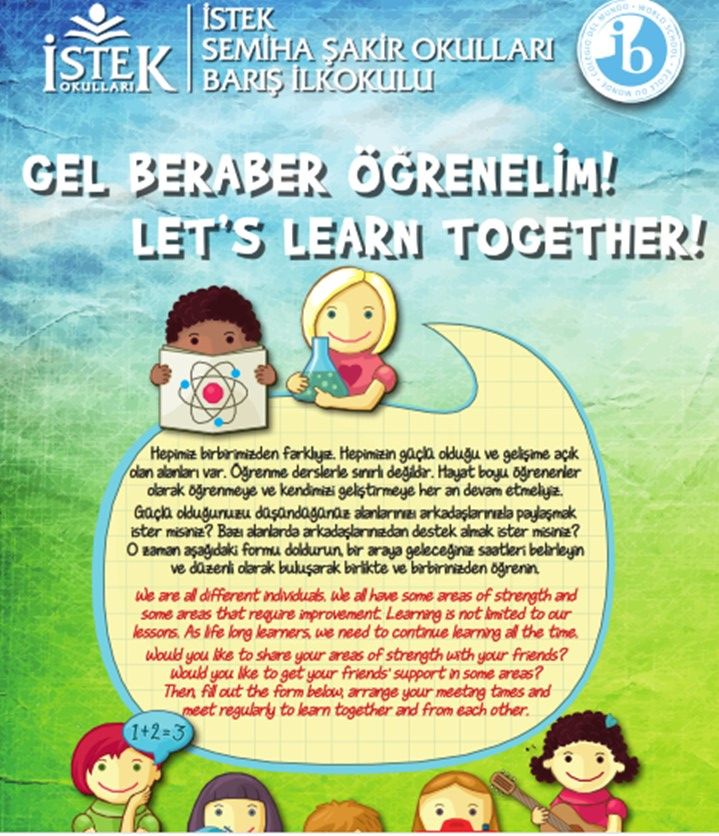
Ceni Alpanda, PYP Coordinator, ISTEK Baris Schools, Turkey
This article is the reflection on the ways a PYP school in Turkey reinforces voice, choice and ownership.
Summer break has always been a perfect time to reflect. This personal reflection on agency is the result of the data gathered through the collaborative reflection done with our school community. In this article, I will share about the ways we reinforce voice, choice and ownership at our school.
Hearing students’ voices and enabling them feel that the school is a place that belongs to them is really important for us. We have an active student council that is formed with representatives from each class. The students get their friends’ suggestions, share them in the regular meetings and after negotiating the suggestions, decisions are made together and implemented at school. The interesting thing about the student council has been that most of the time the students’ suggestions match with our plans about learning and teaching. For example, in the past years the students have asked for increasing the use of the learning environments beyond their classrooms, extending the use of technology and these were areas that we had already planned to keep developing each year.
We feel that knowing the students and their goals is essential. Thus, we ask the students to set their goals for the year and share them in the form of a three-way conference. As the students share both academic and personal goals, this helps them see that their choices are important for us and we are there to support them not only for their academic goals but also for their personal goals (hobbies, interests). During goal setting meetings they share how we can support them as they take action and reflect on their goals throughout the year. We also have portfolio presentations twice each academic year and as the students choose the pieces of work or performance that they want to present, this allows them to organize what and how they want to present.
Individualizing learning is a stance that we feel increases agency. By differentiating instruction according to the students’ needs, interests and learning profile, the students receive the message that we appreciate who they are as learners. When we started to differentiate instruction, our first step was to create an atmosphere where the students felt comfortable about performing–being different. “Let’s Learn Together” project (started 7 years ago) has made a huge positive impact in achieving this. The students think about the areas that they are good at and the areas that they need to further develop. They fill out the charts in their classrooms (see the images below), sharing about the areas that they can support their friends, and the areas they would like to receive support in return. They then organize the times and places that they will come together and learn from each other. This voluntary project has helped the students feel good about what they can do.

 As a result, we learned that many of our students wanted to start interest clubs at school. We see students working on origami, led by a student in one corner of the library, others practicing and sharing techniques about the hula hoop in a corner in the garden, and others writing a scenario together. We offer free time activities that the students select according to their interests, such as drama, chess and dance. These clubs that the students organize themselves, based on genuine choices and interests, give us ideas about we can offer each year.
As a result, we learned that many of our students wanted to start interest clubs at school. We see students working on origami, led by a student in one corner of the library, others practicing and sharing techniques about the hula hoop in a corner in the garden, and others writing a scenario together. We offer free time activities that the students select according to their interests, such as drama, chess and dance. These clubs that the students organize themselves, based on genuine choices and interests, give us ideas about we can offer each year.
The language of instruction in our school is Turkish and all our students speak Turkish as their home and family language. However, some of our students come from bi-cultural backgrounds and to enhance their sense of belonging, we ensure that these languages are represented in our school; with books in the library and sometimes with parents joining our classes.
At the end of each year, we give the students an end-of-year feedback form. We ask them questions about how they feel themselves at school, what they enjoy doing, what they want to do more at school, what supports their learning, what they do while learning something new, what their favourite unit of inquiry was, and a unit that they would plan if they had the chance. The data we gather from the students is invaluable as this helps us see their suggestions for school, and the way they perceive learning and teaching. We analyze and consider their feedback. These feedback forms have been very effective in hearing students’ voices and help us understand how well we have achieved our mission.
I think the real impact of agency is student-initiated action and each year we see that the students are taking their learning further by taking responsible action. During the PYP exhibition, students form groups and select a global issue that they want to learn more about and take local action. As this is a process that the students lead, we see that the students own their work and use their full potential.
Next year, we are planning to offer “I Time” – an hour that the students inquire into a topic or skill that they are passionate about. We also plan to have student representatives in some of our collaborative planning meetings. We will keep improving and deepening our practices to ensure that the students’ voice and choices are heard within our learning community.
Ceni Alpanda is the PYP Coordinator of ISTEK Baris Schools in Istanbul, Turkey and Coordinator of ISTEK Schools’ PYP Coordinators. She is an IBEN member; with the roles of workshop leader, school visit team leader, consultant and reader. She is passionate about PYP and feels privileged to be a part of a large network of PYP educators that helps her learn and grow every day. You can follow her on Twitter @CeniAlpanda.

Loved this article. Very helpful. Thank you.
Dear Ceni,
The points you have mentioned are very important. Congratulations for the solutions you have creaed to hear student’ voice better and implement their suggesrions in your school’s organizational decisions.
Thanks for sharing